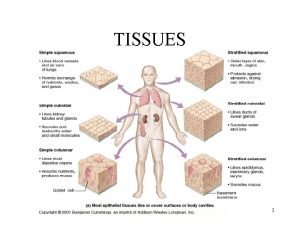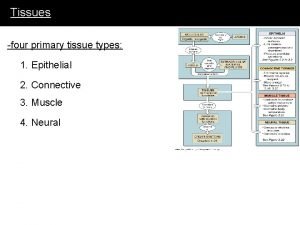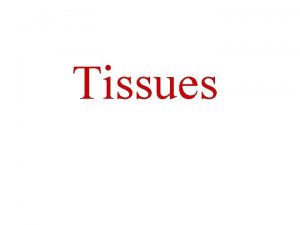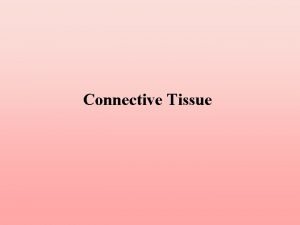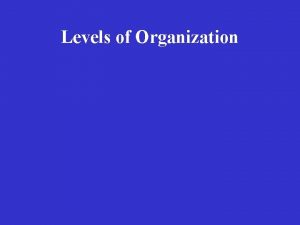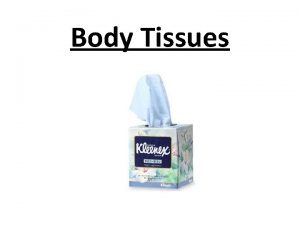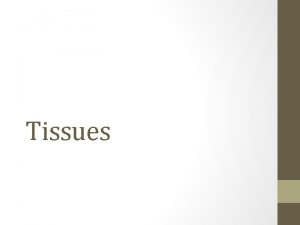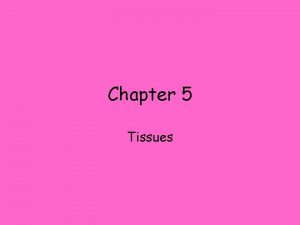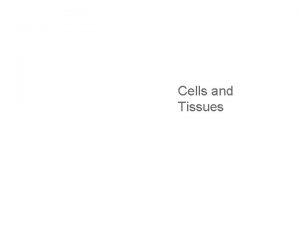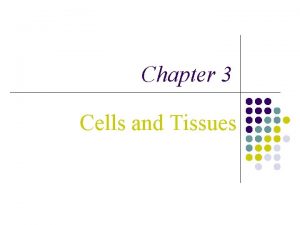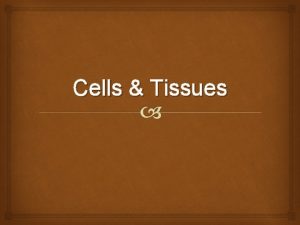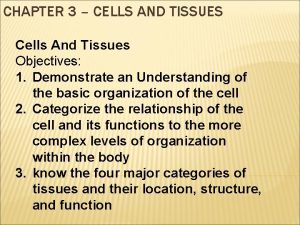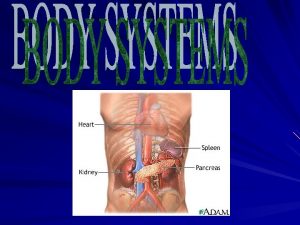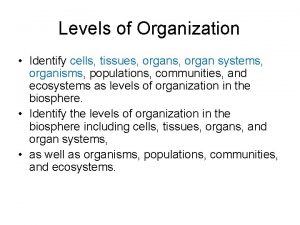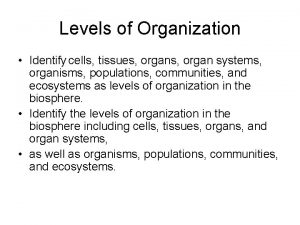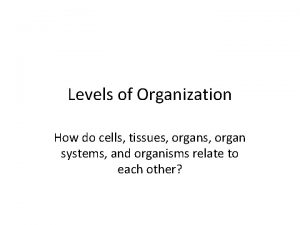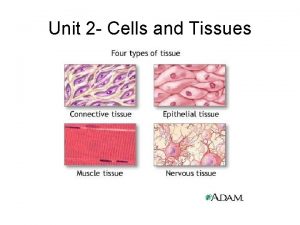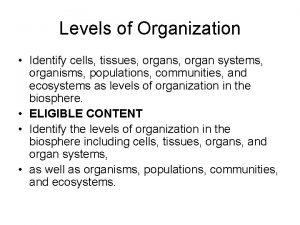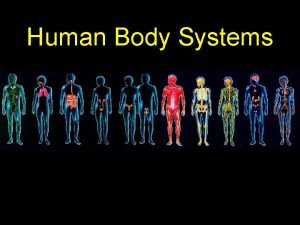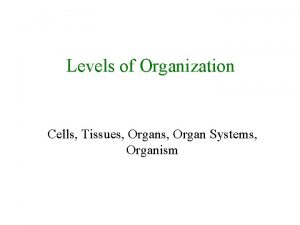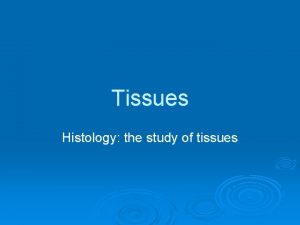The Four Levels of Organization Cells form tissues





























- Slides: 29

The Four Levels of Organization Cells – form tissues Tissues- form organs Organs-form organ systems Organ Systems-form organisms such as you

Cells What is a cell? A Cell is the smallest unit of life where all of the life processes are carried on. “Cell” in Latin means “little rooms” Robert Hooke was the first person to describe cells. He called them “little rooms”

Cell Theory All organisms are made of one or more cells. 2. The cell is the basic unit of all living things. 3. All cells come from existing cells. 1.

What Are the Two Kinds of Cells? Prokaryotes – Bacterial cells n Eukaryotes- Plant and Animal Cells 1. Prokaryote is an organism made of: one cell, does not have a nucleus, does not have membrane covered organelles, has a cell wall & circular DNA. 2. Eukaryote is an organism made of: one or more cells, has a nucleus, and n

What is an Organelle? n An organelle is simply a cell part. Eg. Cell membrane Nucleus Mitochondrion

LIFE PROCESSES Looking at living things

Living things n n n Although all living things look different from each other, they all have seven things in common. These seven things are called life processes. Something is only alive if it does all seven processes.

THE SEVEN LIFE PROCESSES

1 All living things move

n n Animals move their whole bodies to get from one place to another. Plants turn towards the light and their roots grow down into the soil.

2 All living things reproduce

n n Animals have babies. New plants grow from seeds.

3 All living things are sensitive/respond to change

n n n All living things respond to changes. Living things notice changes in their surroundings and react to them. Eg. Plants grow towards the light. Eg. People react to the temperature around them.

4 All living things need nutrition/take in energy

n n n Food is used to provide energy. Green plants make their own food using sunlight. Animals eat plants or other animals.

5 All living things excrete/release waste

n n Waste substances must be removed from the body. Plants and animals both need to get rid of waste gas and water.

6 All living things respire/breathe

n Plants and animals use the oxygen in the air to turn food into energy.

7 All living things grow

n n Babies grow into adults. Seedlings grow into plants.

The seven life processes 1 Move 2 Reproduce 3 Sensitive/respond to change 4 Nutrition/take in energy 5 Excrete/release waste 6 Respire/breathe 7 Grow

Use the first letter from each process to help you remember them. Move Reproduce Sensitive/respond to change Nutrition/take in energy Excrete/release waste Respire/breathe Grow They spell MRS NERG

This is MRS NERG ! Can you remember what each of the letters in her name stand for ?

Move Reproduce Sensitive Nutrition Excrete Respire Grow

Well done !

Tissues There are four kinds of tissues: 1. Epithelial tissue – covers and protects other tissues 2. Muscle tissue-is made of cells that contract and relax to produce movement. 3. Nervous tissue – sends electrical signals through the body. 4. Connective tissue – joins, supports, protects, insulates, nourishes, and cushions organs. It also keeps organs from falling apart.

Organ Systems are made of Organs Which system goes with…. ? Move – Muscular system Reproduce- Reproductive system Sensitive/respond to change- Nervous system Nutrition/take in energy-Digestive system Excrete/release waste- Excretory system Respire/breathe- Respiratory system Grow- Endocrine system Heart – Circulatory system/Cardiovascular Skin – Integumentary system Bones – Skeletal system
 Eisonophil
Eisonophil Body tissues chapter 3 cells and tissues
Body tissues chapter 3 cells and tissues Chapter 3 cells and tissues answer key
Chapter 3 cells and tissues answer key Body tissues chapter 3 cells and tissues
Body tissues chapter 3 cells and tissues Anatomy chapter 3 cells and tissues
Anatomy chapter 3 cells and tissues Tissues are groups of similar cells working together to
Tissues are groups of similar cells working together to Tissues are groups of similar cells working together to
Tissues are groups of similar cells working together to Divisions of anatomy
Divisions of anatomy Chapter 3 cells and tissues
Chapter 3 cells and tissues Chapter 3 cells and tissues figure 3-7
Chapter 3 cells and tissues figure 3-7 Anatomy of a generalized cell figure 3-1 answer key
Anatomy of a generalized cell figure 3-1 answer key A group of cells similar in structure and function
A group of cells similar in structure and function Four levels of organization
Four levels of organization Masses of cells form and steal nutrients from healthy cells
Masses of cells form and steal nutrients from healthy cells Cutaneous membrane
Cutaneous membrane 4 major tissues
4 major tissues Hyaline cartilage location
Hyaline cartilage location Muscle tissue where is it found
Muscle tissue where is it found Tissue are grouped together to form various
Tissue are grouped together to form various Paranasal sinus development
Paranasal sinus development Reabsorption
Reabsorption Parafollicular cells vs follicular cells
Parafollicular cells vs follicular cells Gametic cells vs somatic cells
Gametic cells vs somatic cells Why dna is more stable than rna
Why dna is more stable than rna Red blood cells and white blood cells difference
Red blood cells and white blood cells difference Prokaryotic v eukaryotic
Prokaryotic v eukaryotic Animal cell plant cell venn diagram
Animal cell plant cell venn diagram Prokaryotic cells vs eukaryotic cells
Prokaryotic cells vs eukaryotic cells The organelle trail
The organelle trail Label
Label






